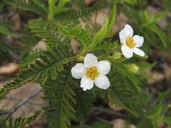Taxon Report
Chamaebatia australis (Bdg.) Abramssouthern mountain misery |
 © 2007 Andrew Borcher |
Taxon Summary
Chamaebatia australis, commonly known as southern mountain misery, is a perennial evergreen shrub in the Rosaceae that is found in California and elsewhere. It occurs within Chaparral (gabbroic, and metavolcanic), growing at elevations from 300 to 1020 meters. Chamaebatia australis is ranked 4.2, Plants of Limited Distribution, A Watch List; Moderately threatened in California.Classification
|
Scientific Name: |
Chamaebatia australis (Bdg.) Abrams |
|
Common Name: |
southern mountain misery |
| Family: | Rosaceae |
| Element Code: | PDROS0A010 |
| USDA Plants Symbol: | CHAU2 |
|
Synonyms/Other Names: |
|
Ecology and Life History
| Lifeform: | perennial evergreen shrub |
| Blooming Period: Nov-May | Nov-May |
| Elevation: | 300-1020 (985-3345) |
| General Habitats: | Chaparral |
| Microhabitat: | |
| Microhabitat Details: |
Conservation Status
| CA Rare Plant Rank: | 4.2 |
| Global Rank: | G4 |
|
State Rank: |
S4 |
| State List: | None |
| Fed List: | None |
| Other Status: | SB_CRES |
|
CRPR Changes: |
|
Occurrence Data from the CNDDB
| Total Occurrences: | 0 |
| Element Occurrence Ranks: | |
| Excellent (A) | 0 |
| Good (B) | 0 |
| Fair (C) | 0 |
| Poor (D) | 0 |
| None (X) | 0 |
| Unknown (U) | 0 |
| California Endemic: False | |
| California Counties and Islands: Name (Code) | |
| San Diego (SDG) | |
| Quads: Name (Quad Code) | |
| Alpine (3211677), Barrett Lake (3211666), Bonsall (3311732), Boucher Hill (3311638), Cameron Corners (3211664), Campo (3211654), Dulzura (3211667), Fallbrook (3311743), Imperial Beach (3211751), Jamul Mountains (3211668), Las Pulgas Canyon (3311734), Margarita Peak (3311744), National City (3211761), Otay Mesa (3211658), Otay Mountain (3211657), Potrero (3211655), Poway (3211781), Ramona (3311617), Rancho Santa Fe (3311712), San Marcos (3311722), San Vicente Reservoir (3211688), Tecate (3211656) | |
Threat List Data from the CNDDB
| Threat List Total: | 0 | |
| EOs with Threat Listed: | Total EOs | % of EOs |
| 0 | 0 % | |
Citation
California Native Plant Society, Rare Plant Program. 2025. Rare Plant Inventory (online edition, v9.5.1). Website https://www.rareplants.cnps.org [accessed 30 November 2025].